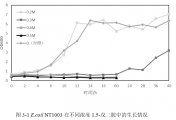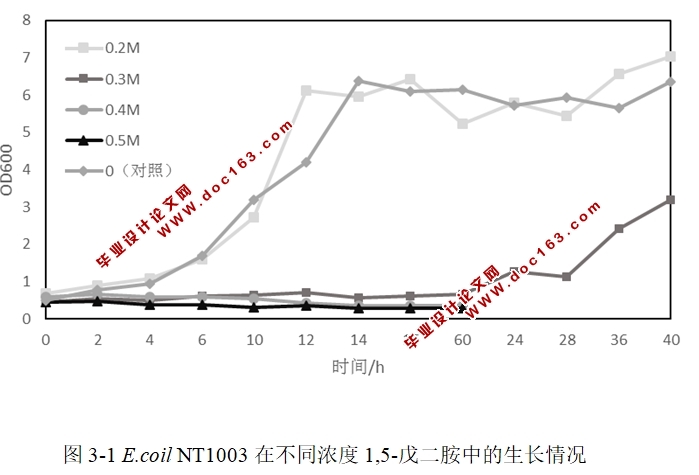大肠杆菌1,5-戊二胺耐受菌株的选育

大肠杆菌1,5-戊二胺耐受菌株的选育(论文10000字)
摘 要
1,5-戊二胺作为一种生物二元胺,在农产品加工生产、医疗保健和工业等领域具有广泛的应用。当前,为实现戊二胺的高效生物合成,利用微生物发酵法直接合成戊二胺的工艺研究受到广泛关注。然而,产物戊二胺对微生物生长以及产品合成具有显著抑制作用,很大程度上降低了1,5-戊二胺的发酵效率,限制了戊二胺的直接发酵合成。因此,为了提高戊二胺生产菌株的耐受性,本课题从实验室生产戊二胺的宿主细胞E. coli NT1003出发,通过常压室温等离子体诱变(ARTP诱变) 技术筛选高耐受性的戊二胺菌株,进而考察了突变菌株对戊二胺的耐受性能以及遗传稳定性,成功将E. coli NT1003对1,5-戊二胺耐受浓度从20 g/L提高到40 g/L。
关键词:1,5-戊二胺 耐受性 大肠杆菌 发酵法
Breeding of 1,5-pentadiamine-tolerant strains of Escherichia coli
Abstract
1,5-pentadiamine, as a bio-diamine, has been widely used in the fields of agricultural products processing, health care and industry. At present, in order to achieve high-efficiency biosynthesis of pentadiamine, the direct synthesis of pentadiamine by microbial fermentation has attracted wide attention. However, the product pentadiamine has a significant inhibitory effect on microbial growth and product synthesis, which greatly reduces the fermentation efficiency of 1,5-pentadiamine and limits the direct fermentation of pentadiamine. Therefore, in order to improve the tolerance of pentadiamine-producing strains, starting from the host cell E. coli NT1003 which produces pentadiamine in the laboratory, we screened pentadiamine-producing strains with high tolerance by atmospheric pressure room temperature plasma mutagenesis (ARTP mutagenesis), and then investigated the tolerance and genetic stability of the mutant strains to pentadiamine. The tolerance concentration of E. coli NT1003 to 1,5-pentadiamine was increased from 20 g/L to 40 g/L.
[版权所有:http://DOC163.com]
Key Words: 1,5-pentadiamine; Tolerance;Escherichia coli; Fermentation method
[资料来源:https://www.doc163.com]

目 录
摘 要 I
Abstract II
第一章 文 献 综 述 1
1.1 1,5-戊二胺的性质及应用 1
1.2 1,5-戊二胺的生物合成方法 2
1.2.1 全细胞转化法 2
1.2.2 微生物发酵法 2
1.3 微生物诱变育种 3
1.4 本课题的研究意义 4
第二章 实验方法和材料 5
2.1 实验菌株 5
2.2 实验仪器 5
2.3 实验试剂 5
2.4 培养基与溶液的配置 6
2.5 E.coli NT1003菌株对戊二胺耐受性测定 7
2.6 菌株诱变及筛选 7
2.6.1 菌株生长曲线的绘制 7 [资料来源:http://Doc163.com]
2.6.2 诱变菌悬液的制备 7
2.6.3 ARTP诱变 7
2.6.4 初筛、复筛方法 8
2.7 突变菌株1,5-戊二胺耐受性验证 8
2.8 突变菌株稳定性考察 8
2.9 分析方法 8
第三章 实验结果与讨论 10
3.1 E.coli NT1003菌株对戊二胺耐受性 10
3.2 耐受菌株的筛选 11
3.2.1 菌株生长曲线的绘制 11
3.2.2 ARTP诱变时间的确定 12
3.2.3 ARTP诱变筛选戊二胺耐受性菌株 13
3.3 突变菌株戊二胺耐受性 14
3.4 突变菌株遗传稳定性测定 15
第四章 总结与展望 17
参考文献 18
致 谢 20
[资料来源:Doc163.com]
